A (Very) Partial Pictorial History of Bugbears
Since my recent forays into the artistic evolution of both kobolds and goblins (not to mention orcs) have proved popular with readers, I thought I'd continue to look into other well-known Dungeons & Dragons monsters for a few more weeks. This time, I'm looking at the bugbear, both because it's completely unique to D&D, but also because, with one very important exception, its representation in artwork has been very consistent – far more so than any of the previous monstrous humanoids I've examined so far.
Of course, that one exception is a big one. More than that, it's the original illustration of the bugbear, as drawn by Greg Bell in OD&D's Supplement I (1975). Look upon his majesty!
 I actually really like this illustration, because it's just so weird. That pumpkin head – the result of a miscommunication between Bell and Gygax – makes it quite clear that you're dealing with a wholly inhuman monster, despite its two arms, two legs, and upright stance. These days, this is how I prefer my monstrous humanoids, so I may be unduly biased toward it. Regardless, it's an oddity and an outlier that no subsequent TSR era D&D artist has ever used as inspiration for his interpretation of it – a pity!
I actually really like this illustration, because it's just so weird. That pumpkin head – the result of a miscommunication between Bell and Gygax – makes it quite clear that you're dealing with a wholly inhuman monster, despite its two arms, two legs, and upright stance. These days, this is how I prefer my monstrous humanoids, so I may be unduly biased toward it. Regardless, it's an oddity and an outlier that no subsequent TSR era D&D artist has ever used as inspiration for his interpretation of it – a pity!With the AD&D Monster Manual (1977), we see the first examples of what will eventually become the iconic appearance of the bugbear – little wonder, since it's by Dave Sutherland, the artist most responsible in my opinion for the esthetic of old school D&D.

Here's another instance of a bugbear from the Monster Manual, this time drawn by Dave Trampier. I find this second piece interesting, because it's clear that Tramp is using Sutherland's illustration above as a model. These are clearly the same monster drawn by two different artists.
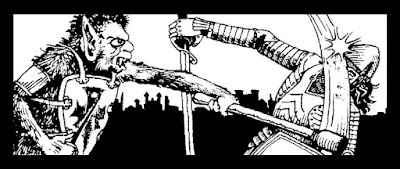 Speaking of Tramp, he drew another early bugbear illustration, which appeared in 1978's Descent into the Depths of the Earth. Once again, this is clearly the same monster as those depicted in the MM, but, this time, they have a slightly more cartoonish look to them, almost like characters out of Trampier's Wormy comic.
Speaking of Tramp, he drew another early bugbear illustration, which appeared in 1978's Descent into the Depths of the Earth. Once again, this is clearly the same monster as those depicted in the MM, but, this time, they have a slightly more cartoonish look to them, almost like characters out of Trampier's Wormy comic.
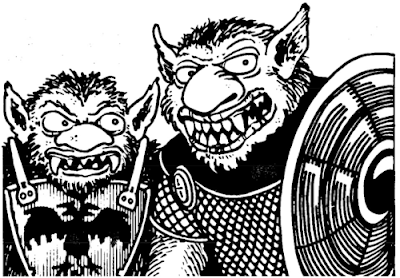 Next up are some Grendadier Model sculpts of bugbears from 1980. As you can see, these, too, are in keeping with the basic appearance laid down by Dave Sutherland a few years earlier – big, furry brutes with wide mouths full of sharp teeth and large ears.
Next up are some Grendadier Model sculpts of bugbears from 1980. As you can see, these, too, are in keeping with the basic appearance laid down by Dave Sutherland a few years earlier – big, furry brutes with wide mouths full of sharp teeth and large ears.
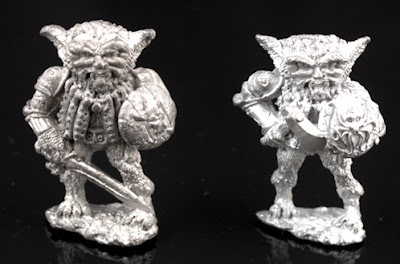 1980 was also the year in which Deities & Demigods appeared. Though bugbears as such do not appear in the book, we do get a depiction of their deity, Hruggek, as drawn by Dave LaForce. I'm not fond of this illustration, which I've always found a bit goofy. Maybe it's the grin, I don't know. Still, it's broadly in keeping with what we've come to expect of bugbears up till now.
1980 was also the year in which Deities & Demigods appeared. Though bugbears as such do not appear in the book, we do get a depiction of their deity, Hruggek, as drawn by Dave LaForce. I'm not fond of this illustration, which I've always found a bit goofy. Maybe it's the grin, I don't know. Still, it's broadly in keeping with what we've come to expect of bugbears up till now.
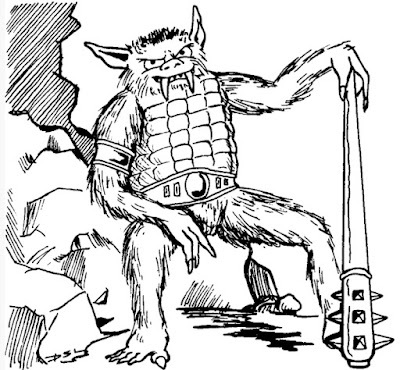 In 1982, the
AD&D Monster Cards
include a bugbear, its illustration done by Jim Holloway. This may be the first piece of color artwork for the monster in the history of the game.
In 1982, the
AD&D Monster Cards
include a bugbear, its illustration done by Jim Holloway. This may be the first piece of color artwork for the monster in the history of the game.
 Second Edition's Monstrous Compendium (1989) includes this artwork, again by Jim Holloway. While still largely in keeping with its predecessors, I notice that the bugbear's face is now arranged more like that of a human being. Both its mouth and ears are smaller, for example, though its nose remains large and broad.
Second Edition's Monstrous Compendium (1989) includes this artwork, again by Jim Holloway. While still largely in keeping with its predecessors, I notice that the bugbear's face is now arranged more like that of a human being. Both its mouth and ears are smaller, for example, though its nose remains large and broad.
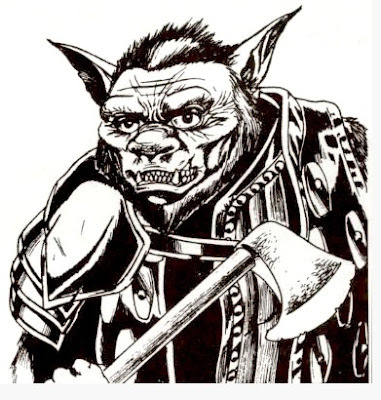 Finally, there's Tony DiTerlizzi's take on bugbears from 2e's Monstrous Manual (1993). I'm not sure what to make of this illustration. While it retains the overall look of Sutherland's original, I feel like it continues down the path laid down by the Monstrous Compendium of giving bugbears human proportions, which undercuts their monstrousness, something I've come to see as a mistake in the portrayal of D&D's humanoid monsters.
Finally, there's Tony DiTerlizzi's take on bugbears from 2e's Monstrous Manual (1993). I'm not sure what to make of this illustration. While it retains the overall look of Sutherland's original, I feel like it continues down the path laid down by the Monstrous Compendium of giving bugbears human proportions, which undercuts their monstrousness, something I've come to see as a mistake in the portrayal of D&D's humanoid monsters.
 I am certain I've overlooked several other examples of bugbear illustrations from TSR era Dungeons & Dragons. Feel free to point me toward others that you've found. I'm particularly interested in any examples of bugbears that, like Greg Bell's OD&D version, deviate greatly from the model laid down by Sutherland. My suspicion is that there won't be many (or any) such examples, because, for whatever reason, most old school D&D illustrators more or less followed in the footsteps of their predecessors, something we don't see in quite the same way with many other monsters. I wonder why that is.
I am certain I've overlooked several other examples of bugbear illustrations from TSR era Dungeons & Dragons. Feel free to point me toward others that you've found. I'm particularly interested in any examples of bugbears that, like Greg Bell's OD&D version, deviate greatly from the model laid down by Sutherland. My suspicion is that there won't be many (or any) such examples, because, for whatever reason, most old school D&D illustrators more or less followed in the footsteps of their predecessors, something we don't see in quite the same way with many other monsters. I wonder why that is.
Published on June 24, 2024 09:30
No comments have been added yet.
James Maliszewski's Blog
- James Maliszewski's profile
- 3 followers
James Maliszewski isn't a Goodreads Author
(yet),
but they
do have a blog,
so here are some recent posts imported from
their feed.



